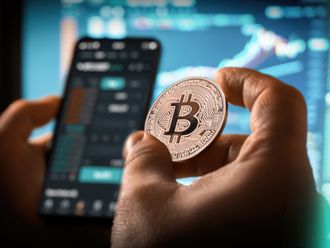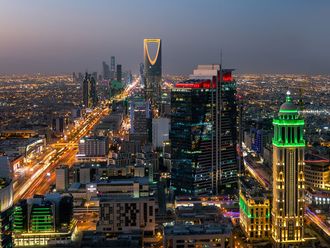
QE2, not the British icon docked off the waters of Dubai but the US Federal Reserve's latest $600 billion (Dh2.2 trillion) buying spree of Treasury bonds to stimulate the economy, has not had the anticipated impact so far on the region.
Much of it priced before the actual announcement, Dubai and Abu Dhabi stocks have moved down in response to local news of some disappointing corporate results and a lagging recovery environ.
That is not to say that there are not going to be beneficiaries of QE2 (second round of quantitative easing).
But first, buy growth stocks in the broader Mena region, then those positively impacted by QE2. That's the advice from Bank of America Merrill Lynch's latest Mena Quarterly which was published ahead of the Federal Reserve's announcement last Saturday, though it points out the choices overall are limited. "Growth stories in the region are underappreciated, so investors should follow them rather than the excitement of the QE2," said London-based Turker Hamzaoglu, economist, Emerging Europe, Middle East and Africa, Bank of America Merrill Lynch during an interview with Gulf News in Dubai last week.
For 2011, the investment bank advises investors to stay long on Saudi Arabia, Egypt and Qatar because of improving fundamentals, albeit modestly. On UAE and its recovery prospects, it's not such good news, though they have a few names recommended as being beneficiaries of QE2.
Preferences
"While risk appetite has improved with QE2 and we expect liquidity will remain favourable for much of the remainder of the year, we think investor preferences will remain overwhelmingly in favour of visble growth stories, rather than future growth stories, unless it becomes clear that the US growth will not double dip," the Quarterly states.
"In the meantime we expect the market to remain focused on countries that already have self sustaining recovery and are effectively the least vulnerable to US double dip concerns."
Showing growth in 2009-2010, Saudi Arabia, Egypt and Qatar fit in to the exclusive club of the best performing markets globally, though their equity performance have lagged.
For UAE markets to really start moving forward on a sustainable basis, there is a need to banish all concerns about the global growth picture, Stephen Pettyfer, managing director and head of Mena research at Bank of America Merrill Lynch Global Research told Gulf News.
The report elaborates the point further: "As the UAE's recovery is likely to be among the last globally, it seems premature to buy the UAE for growth until we are comfortably in an environment where liquidity remains abundant and US double dip fears have disappeared. We believe that seems unlikely until early 2011 at the earliest."
The types of companies listed in the UAE don't give you diversity, Pettyfer said. "The focus on these two sectors [property and banks] mean that we have to get that much more confidence in their balance sheets." And this is the reason they are underweight on UAE. It is very much a pick and choose depending on the market, he added.
Among the top picks for 2011 growth: In Qatar, it's Doha Bank, in Saudi Arabia, it's the telecom provider Mobily; and in UAE it's the construction company Drake and Scull International (DSI). The rationale behind the selection of the growth stocks is quite obvious. DSI is driven by rising construction revenues in Saudi Arabia and Qatar. As for Doha Bank, the Bank of America Merrill Lynch analysts forecast 17 per cent loan growth in 2011.
The analysts don't cover etisalat and du because of their foreign ownership restrictions. But the Mena telecom sector in general does not find much favour with them.
Exception
Mobily in Saudi Arabia is the one exception because it exhibits a rare case of growth," said Pettyfer. "Others for one reason or other are not growing as much because competition is starting to bite."
On impact of QE2 on Mena banks in general, the Quarterly writes that it (QE2) "will have positive implications on bank fundamentals for systems where improved access to wholesale funding is most positive as well as economies more exposed to the global backdrop."
UAE and Oman would be the biggest beneficiaries, it says, and the QE2 picks are: First Gulf Bank and Union National Bank both in Abu Dhabi, Bank Muscat in Oman, Qatar National Bank in Qatar, and in Egypt is Commercial International Bank (CIB) and EFG-Hermes.
First Gulf Bank, at 1.3 times current price to book value (PBV) is inexpensive and despite government support, has limited Dubai exposure, with just 15 per cent of loans. It has also a 18 per cent sustainable return on Investment.
Union National Bank (UNB) is appealing at 0.85 times current PBV is also considered cheap and with Abu Dhabi focus and a more conservative balance sheet and a 15 per cent sustainable ROE. Bank Muscat, the Quarterly points out, will "benefit from cheaper funding and wholesale access (loan to deposit [LTD] at 117 per cent), local banking system remains healthy with limited asset quality issues constraining positive impact of QE2."
CIB and EFG-Hermes were choices as being part of the banking sector which is a beneficiary of QE2. The Egyptian market should benefit from improved risk appetite, Pettyfer said.
Buy growth first, then QE2
- 2011 Growth stocks: Mobily, in Saudi Arabia; Doha Bank in Qatar; and Drake and Scull International in UAE
- QE2 beneficiaries: First Gulf Bank and Union National Bank in UAE; Bank Muscat in Oman; and Commercial International Bank and EFG-Hermes in Egypt.
— Source: Bank of America Merrill Lynch












